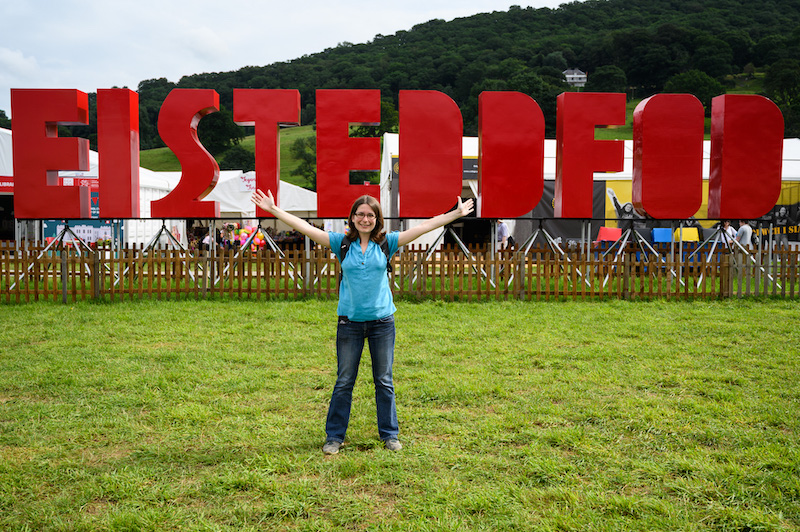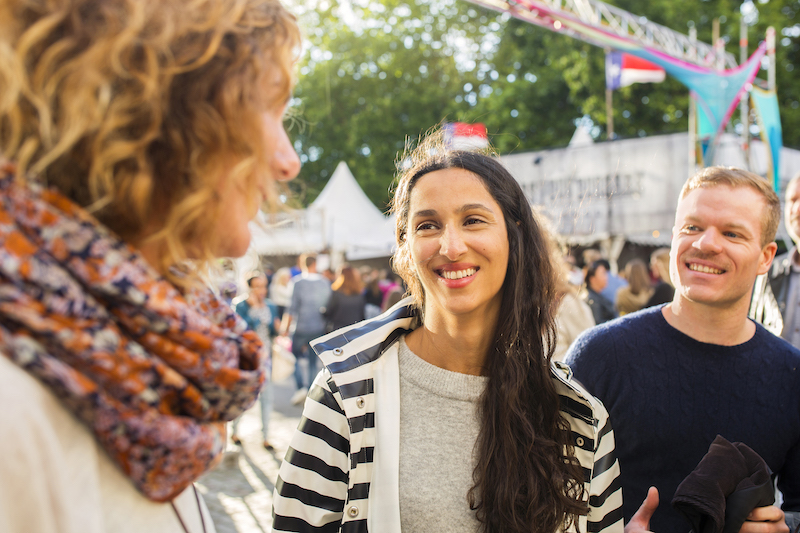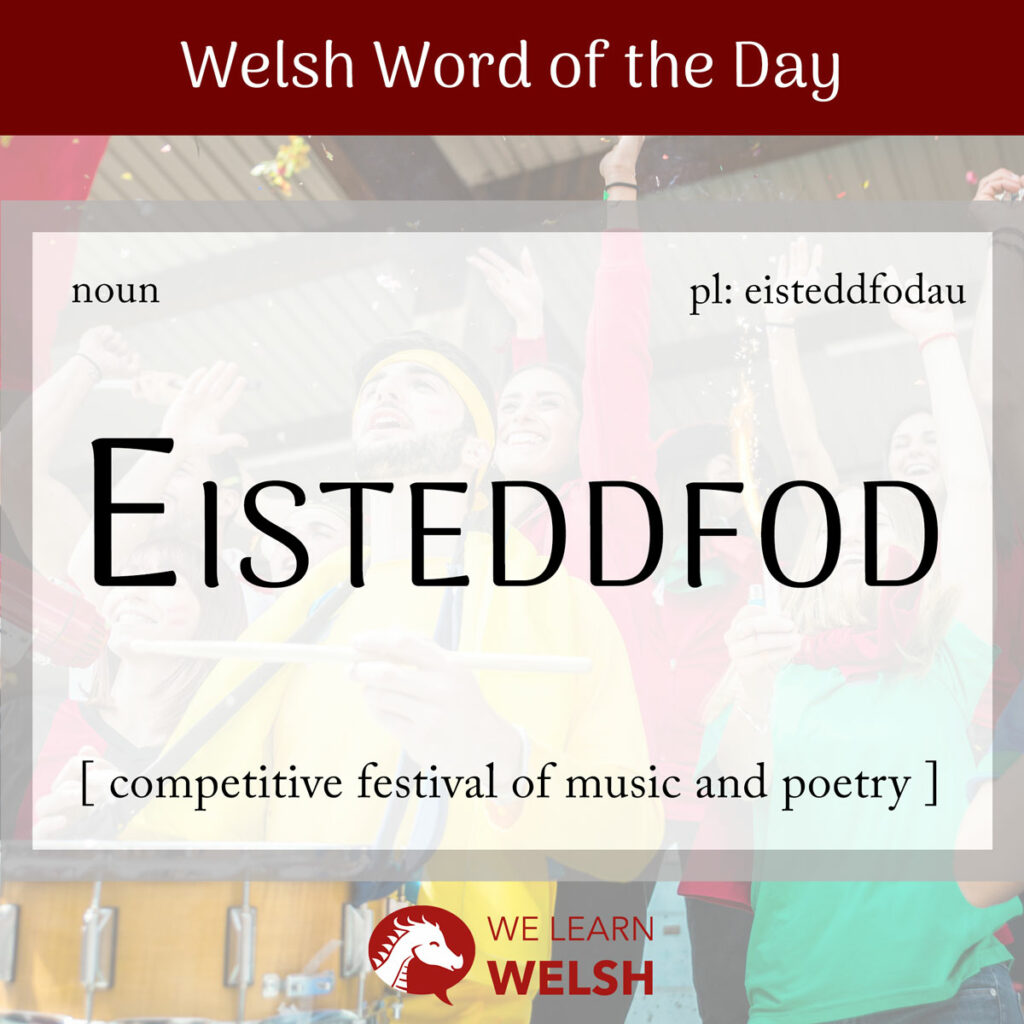Any good linguist will tell you that languages aren’t isolated, scientific phenomena—they are deeply woven into the history and culture of the people who speak them.
With that in mind, learning Welsh isn’t just about mastering vocabulary and grammar; it’s about immersing yourself in the country’s rich traditions. Perhaps the most iconic of these is the eisteddfod, a festival of music and literature centred around competition. The plural form is eisteddfodau.
eisteddfod
Wales is well known for being Gwlad y Gân (the Land of Song). From the classic alaw werin (folk tune), to modern pop and rock bandiau (bands), to the majestic voices of the traditional male voice choir, cerddoriaeth (music) and canu (singing) are integral to our culture.
Indeed, the national anthem makes this clear in only its second line:
Mae hen wlad fy nhadau yn annwyl i mi,
Gwlad beirdd a chantorion, enwogion o fri;
The old land of my fathers is dear to me,
A land of poets and singers, famous and honourable men
From the oldest days of the Welsh poetic and musical tradition, there were strict rules regarding composition.
These can be summed up in the general concept of cynghanedd, usually translated as harmony. Cynghanedd refers to patterns of alliteration, rhyme and stress that define certain kinds of Welsh barddoniaeth (poetry). Writing and performing cerddoriaeth and barddoniaeth was seen as a serious, important, and difficult galwedigaeth (vocation).
The earliest eisteddfodau, then, likely originated as a kind of testing grounds for would-be beirdd (bards) and clêr (minstrels) to prove their talents.
The first eisteddfod that we definitely know occurred was held in Castell Aberteifi (Cardigan Castle) in 1176, by Yr Arglwydd Rhys (Lord Rhys), prince of much of De Cymru (South Wales) at that time.
It was held around the time of Nadolig (Christmas) and was advertised a year in advance with guests travelling to attend from as far as Ffrainc (France) and Iwerddon (Ireland). Although it is not certain that the word eisteddfod was actually used to describe this event, it’s commonly commemorated as the ancestor of the traddodiad (tradition).
The gŵyl consisted of a gwledd (banquet) and competitions in barddoniaeth and cerddoriaeth. For both disciplines, a ceremonial cadair (chair) was awarded to the winner, as at this point in history they were valuable goods which only high-status people had access to. This important custom has been preserved and is still celebrated in eisteddfodau today.
Mae hi wedi ennill y gadair yn yr eisteddfod.
She has won the chair at the eisteddfod.
The word eisteddfod itself – often capitalised, Eisteddfod, in order to refer to particular events – is a curious one. It clearly derives from the verbs eistedd (to sit) and bod (to be), so perhaps it refers to participants sitting together to celebrate the festival.
Eisteddfod is considered a feminine noun. It’s often shortened to ‘steddfod colloquially.
And, since there is obviously no English translation or equivalent for this concept, another variant you may hear is the Anglicised pronunciation! English-speaking people usually pronounce it more like aisteddfod instead of eisteddfod. In this case, it might be pluralised as eisteddfods instead of the standard Welsh eisteddfodau. This Anglicisation also gave rise to the English word eisteddfodic (relating to an eisteddfod).
Although they’re not used very much, there are some fun Welsh words derived from eisteddfod, too. An eisteddfodwr (male) or an eisteddfodwraig (female) are people who often go to eisteddfodau, and the verb describing the action of doing so is eisteddfota.
Eisteddfodwyr ydyn ni, ‘dyn ni’n mynd bob blwyddyn.
We’re real eisteddfod-goers, we go every year.
There are various eisteddfodau held in today’s Wales, since the tradition was resurrected in the 1800s. Most prominently, there is yr Eisteddfod Genedlaethol (the National Eisteddfod). It lasts eight days and it is Europe’s largest festival of music and poetry. It’s held in a different location in Wales each year, with 2024’s being held in Pontypridd, near Caerdydd (Cardiff), and attended by nearly 200,000 people.
The most important and well-known gwobrau (prizes) at yr Eisteddfod Genedlaethol are those for barddoniaeth (poetry). These are the cadair (chair), given for an awdl, which is a poem written in the style of cynghanedd, and the coron (crown), which is given either for a free-verse poem, or, in some eisteddfodau, for a piece of prose writing. These huge honours can be, and fairly often are, withheld, if no entry is considered to be of the required standard.
The cadair eisteddfodol is presented in a unique and iconic ceremony, conducted by the Archdderwydd, a special official who presides over the eisteddfod. The Archdderwydd must themselves be a previous winner of the cadair, coron, or the medal for prose.
In the ceremony, the winner of the prize is draped in a decorated robe. They ascend to the stage and sit in y gadair (the chair) itself. The current Archdderwydd lifts a ceremonial cleddyf (sword) above them.
They then ask of those gathered to observe the question A oes heddwch? (is there peace?) This is done in order to show that the entire community of the eisteddfod approves of the chosen victor. The question is repeated three times, and each time the entire audiences replies with the chorus Heddwch! (Peace!). The Archdderwydd is thus given permission to officially grant the winner their victory.
Beth yw dy hoff gystadleuaeth ‘steddfod?
What’s your favourite competition of the eisteddfod?

Aside from yr Eisteddfod Genedlaethol, most towns will hold an eisteddfod bro (local eisteddfod). Ysgolion (schools), too, often hold their own event. In the town of Llangollen, an annual international eisteddfod is held, celebrating folk traditions from all over the world.
Beth am i ni fynd i’r Eisteddfod Genedlaethol eleni?
How about we go to the National Eisteddfod this year?
And the very important Eisteddfod yr Urdd is the junior equivalent of yr Eisteddfod Genedlaethol. Each year, around 40,000 Welsh children compete via local and regional eisteddfodau to be able to perform in Eisteddfod yr Urdd!
As you can imagine, many Welsh childhoods are punctuated by attending and competing in various eisteddfodau throughout the year. Mine was no different, and my siblings and I all have many fond memories of days spent in village halls, watching our friends compete and competing ourselves.
We always took Eisteddfod yr Urdd and its qualifying rounds very seriously, but I was especially proud the year I won y gadair in my school eisteddfod. Barddoniaeth was my favourite competition—I entered every year, both in recitation and writing. Over the years, we also took part in a variety of other contests, including:
- canu = singing
- canu piano = playing piano
- canu ffliwt = playing flute
- côr = choir
- cerdd dant = improvised singing
- ymgom = short drama
- darllen y Beibl = Bible reading
- paentio = painting
- llawysgrifen = handwriting
- coginio = cooking
None of the three of us were ever talented enough to take part in the dawnsio (dancing), though! We happily left that to the more graceful competitors.
Eisteddfodau were taken very seriously at school, too – in the run up to Eisteddfod yr Urdd or to the school eisteddfod we would have at least an hour of the school day taken up by practising our singing and recitations.
Gobeithio y bydda i’n cael fy newis ar gyfer yr ymgom.
I hope I’ll be chosen for the ymgom.
Despite my best efforts, I never qualified to perform on the main llwyfan (stage) at Eisteddfod Genedlaethol yr Urdd. But most years we would still attend as a family and enjoy watching the acts and visiting the stalls on y maes (the field, which is where eisteddfodau are held), as well as getting to visit a new part of Wales. It was also very exciting whenever someone we knew got to the final stages of the competition, as those performances were broadcast live on S4C.
In 2018, though, we didn’t get to visit anywhere new as the event was held in Llanfair-ym-Muallt (Builth), the town where we went to school. It was a great location for it as Llanfair-ym-Muallt is famous for its agricultural shows held on the maes. And it was very exciting as a resident of this super-rural area to have people travelling to mid-Wales from all over the country!
There couldn’t have been a better year, then, for my very talented little sister, Elin, to win second place nationally in the cystadleuaeth (competition) for piano solo – as well as instrumental duet, along with our lovely friend Amy.
Elin and Amy actually entered the duet competition again the next year and won first place in the eisteddfod, that year held in Caerdydd (Cardiff). But my favourite memory will always be seeing her cute face on teledu (television) for the first time in 2018. I hope you don’t mind me showing her off!


